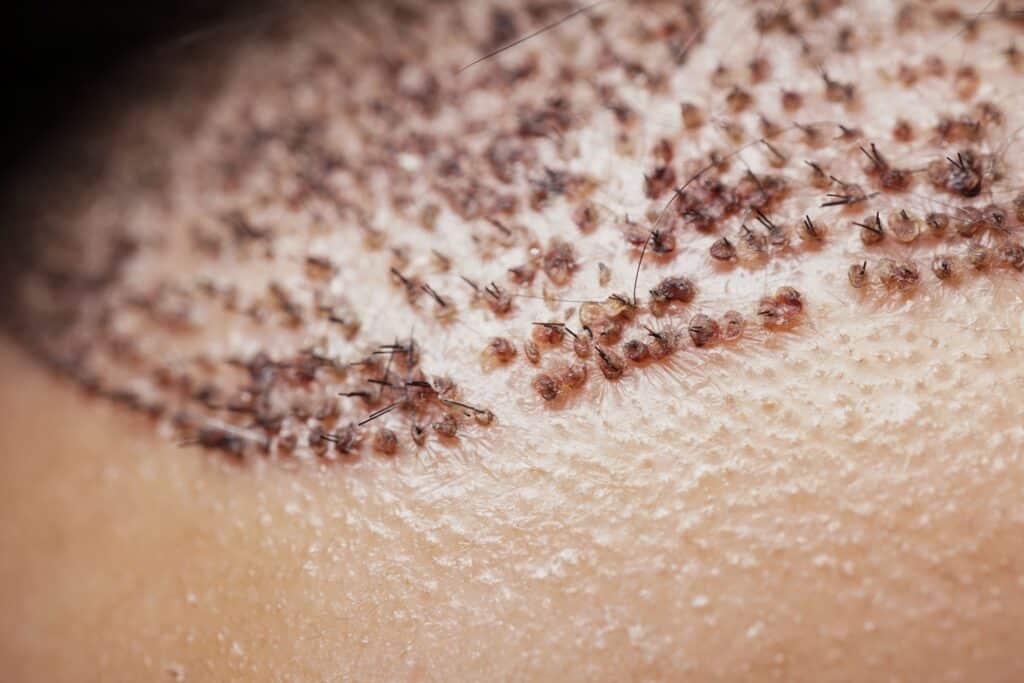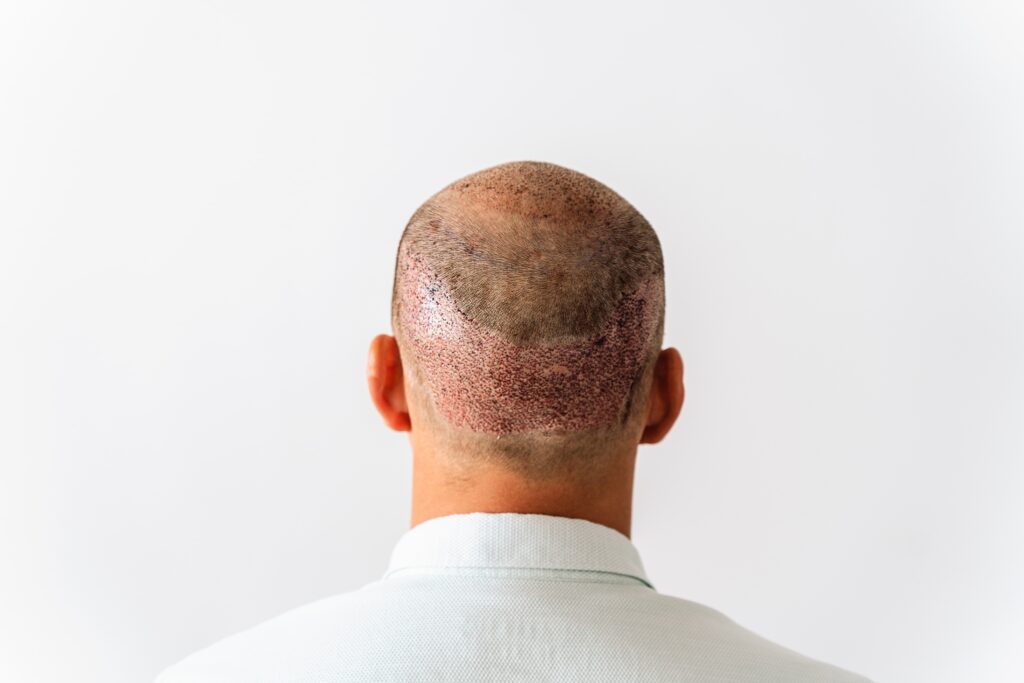All type of hair transplants leave scars on the scalp of some sort. The question is just, how big is the scarred area and is it visible?
A traditional Follicular Unit Transplant (FUT) procedure leaves a line shaped scar on the donor area at the back of the head. Patients need to wear their hair at a minimum length to hide this linear scar.
FUE hair transplantation procedure (Follicular Unit Extraction) leaves micro scars at the back of the head. These are very small and will not be visible if the hair is a reasonable length. However, after a FUE hair transplant surgery, scars on the donor area are sometimes visible if the hair is shaved short.
The most modern surgical procedures can effectively minimize transplant scars. Micro Sapphire FUE hair restoration procedures minimise scarring by making finer incisions than traditional Follicular Unit Extraction (FUE) procedures.
Even better, Micro Sapphire DHI leaves dot scars so small that they can be described as micro scars. This treatment offers the best healing process, with minimal scarring. It also has the best hair transplant before-after results on the market.
This happens because surgeons use incision tools made of the precious stone sapphire, which are much finer and more accurate than traditional steel tools.
Hair transplantation procedures on already existing scars

Almost no major wound heals without leaving scars. A burn, a chemical burn, an accident, or an operation can all leave major damage to skin tissue.
When they are located on the head, scars can be particularly upsetting. Hair can no longer grow from scar tissue under its own power and thus bald patches can form.
Some people use hair pigmentation to cover their scars, but sometimes this is no longer sufficient. In these cases, a hair restoration surgery can cover visible scars.
When is a hair transplant on a scar an option?
In general, surgeons can perform a hair transplant on any scar that still has blood supply and has completed its scarring process.
If a scar on the head severely impairs quality of life, a hair transplant can do a lot to provide a long-lasting visual cover.
The remaining hairs around many scars cannot completely cover them. Poor quality and botched hair surgeries, especially with the FUE or FUT methods, can also leave unsightly scars on the scalp.
In all these cases, a professional hair transplant in Turkey can help the patient to cover up a scar. Various techniques are available for this purpose.
Can you transplant hair onto any scar?
Generally, surgeons can perform a hair transplant on any scar. However, they sometimes need to prepare the scar by removing excess tissue if the scarring involved severe tissue growth.
Unfortunately, there are also scars that continue to grow permanently, whose tissue proliferates permanently. Hair transplantation cannot achieve long-term success on such scars if scar growth continues.
Surgeons need to conduct a thorough preliminary examination to determine whether they can implant grafts directly into scar tissue.
What technique is best to transplant hair onto a scar?
The aim of a hair transplant on scar tissue is to make the scar disappear visually. In the case of strip-shaped scars, it may be sufficient to remove the scar and overlap surrounding skin tissue.
This is a form of scar repair. If necessary, surgeons can transplant the patient’s own hair afterward.
The slit technique for particularly thin areas of skin

The slit technique uses extremely fine scalpels. With these scalpels, the hair transplant surgeon makes incisions in the skin in the natural direction of hair growth. Surgeons then insert the grafts in the direction of growth. They often use this technique in the area of the temples or eyebrows, where vertically inserted hair follicles are quickly noticeable.
The advantage of the slit technique is that it is not noticeable even when looking closely from close up. The hairs blend in naturally. In areas of the scalp with thin skin, this technique helps to achieve a natural appearance of the hair.
The Micro Holes Technique
In the micro holes technique, surgeons insert the grafts into particularly small channels using fine instruments. They place the grafts as close as possible to existing capillaries, especially in areas with poor blood supply. This improves the blood supply to the transplanted follicles. In this way, a surgeon can achieve a much higher graft success rate.
How long does a hair transplant on scar tissue take?
The duration of a hair transplant operation on a scar depends on its size. Removal of scar tissue extends the treatment time. The use of the slit or micro hole technique also makes a hair transplant take longer than a standard one.
In total, you should allow at least two to four hours for a hair transplant on a scar. If the scar is larger, it can take even longer.
The aftercare of a hair transplant is the same as a standard hair transplant without scars. Clear results are already visible after around 3 to 6 months. After about a year, you can enjoy a full, healthy-looking head of hair again.
FAQ
Yes, all hair transplant procedures result in some form of scarring. However, the size and visibility of these scars vary. FUT leaves a line-shaped scar, while modern methods like Micro Sapphire DHI result in nearly invisible, micro dot scars.
Generally, hair can be transplanted onto existing scars as long as the scar has adequate blood supply and has completed its scarring process. Proper preliminary examinations are necessary to ensure grafts can be successfully implanted into the scar tissue.
Several techniques are used for hair transplantation on scars, including the slit technique and the micro holes technique. These methods aim to achieve a natural appearance by using fine scalpels and inserting grafts in the natural direction of hair growth.
While most scars can be treated with a hair transplant, some scars with excessive or continuous tissue growth might not achieve long-term success. Detailed preoperative evaluations are crucial to determine the suitability for the procedure.
The duration of a hair transplant procedure on scar tissue depends on scar size and whether scar tissue needs removal. Generally, the process takes about two to four hours, but larger scars may extend the procedure time. Results are visible within 3 to 6 months.




